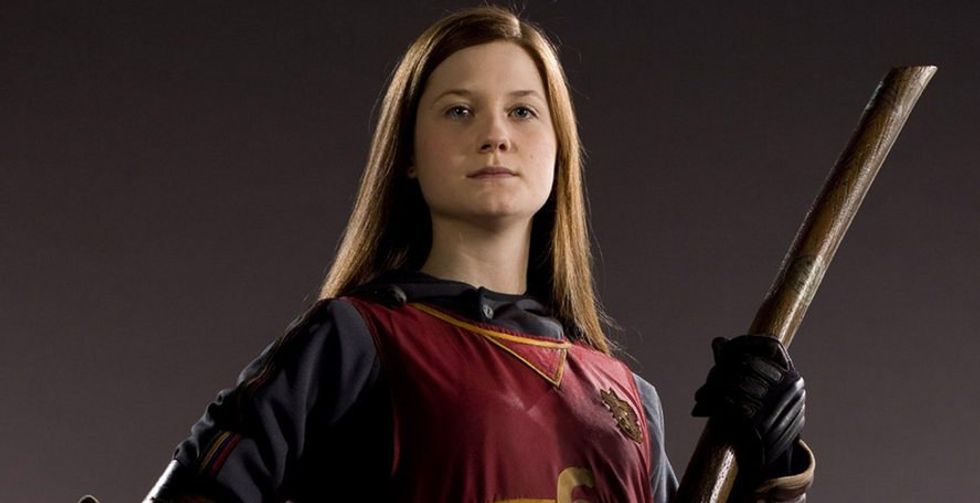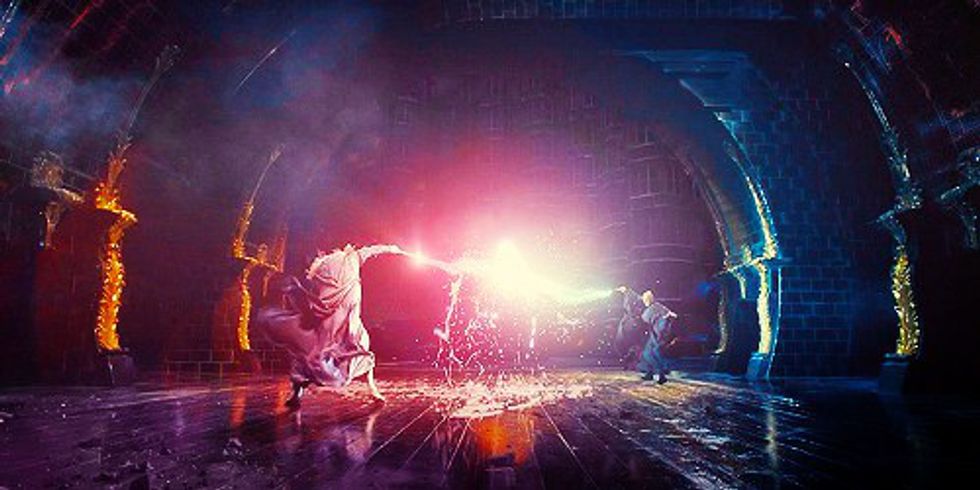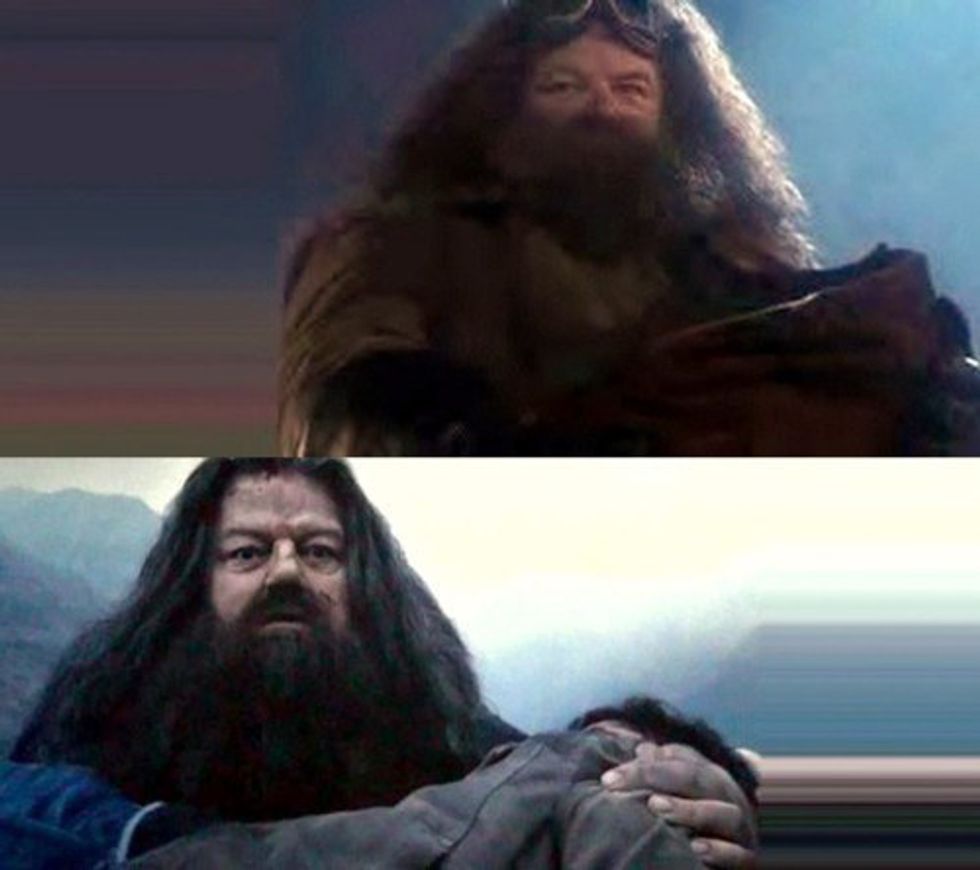Whenever screenwriters, directors, and editors take a story from the page to the screen they have to change a lot and plenty gets lost in translation. Not to say that it can’t be done well, but no matter what something has to be left behind. The Harry Potter series is one example of this. The movies are great, I should know I own them all, but they still miss some of the important parts of the books which means that those that just watch the movies are missing out.
Characters:
One thing that commonly gets lost in the transition is characters. Some characters are changed because the movies didn’t take the time to show them fully. Instead their plot-important aspects are chosen and the rest is left behind. For example, in the books, Ginny was sassy, powerful, and independent. But in the movies, Ginny doesn't get enough screen time to show her personality, there is no character development, and she only revolves around Harry. She is not treated like her own character, only as Harry’s love interest.
Another character that was changed was Amos Diggory. In the books, Amos is boastful, proud, and impolite. He takes pride in boasting about his son, just as any proud parent would. In the film however, he was portrayed as a nice man with an affable personality, he does not boast about Cedric. This was likely done to create sympathy towards Amos as a character at the film's conclusion. Amos Diggory was changed to control the audience's opinion of him without having to give him the time he has in the books. In the books, losing Cedric is heartbreaking for him, it was his rudeness that showed how proud he was of his son. But in order to convey this to the audience he would have required more time on screen and it was simpler for his character to be polite so little work was required for the audience to feel sympathy for him.
Although not all character changes were bad. for example, Professor Slughorn was made much more complex when he talks about teaching Lilly when she was in school. It makes him a lot more likable when there wasn’t a lot of redeeming qualities about him in the books. Him changing his memory of telling Voldemort about the Horcruxes instead of hiding it also has greater complexity since it represents the person that he wishes he was as opposed to a jerk that just ran away from his past.
Several characters are completely left out of the movies, although they may not all have been significant for the plot they did add something to the story. For example, Peeves appeared in every books but was not in any of the films. For those who don’t know, Peeves was a poltergeist at Hogwarts since its founding it says he “came with the building” and he is fond of mischief and chaos. He is known for being a pain to Filch the school’s caretaker who requested every year that Peeves be kicked out, he never was. He showed no one respect except for The Bloody Baron who he feared and Dumbledore perhaps because he didn’t want to be kicked out. Significantly, he pranked Umbridge from the moment she arrived to the moment she left as the Weasley twins had asked him to “give her hell from us.” It is the only instance of Peeves knowingly obeying a student. He also fought in the Battle of Hogwarts by dropping Snargaluff pods on the Death Eaters. For the most part Peeves is just seen as a comedian and a side story.
Some argue that the side stories in books take away from the plot, and in these books they take away from Harry, who should be the central focus since this is his coming of age story. Although Peeves doesn’t play a significant role in Harry’s life, these side stories add complexity to the world the story is set in. The wizarding world can only be seen through the books or movies as none of us got a letter to Hogwarts and if all of the side stories are left out we don’t get to learn about everything. By excluding characters and side stories we have a very narrowed scope of what life would be like as any wizard other than Harry Potter and his friends.
That being said, there are also some plot-important characters missing from the movies as well which leads to confusion as the story is not told completely or in this case not told at all. The Gaunts family had been wealthy purebloods descended from Salazar Slytherin. By the early 20th century they had been reduced to poverty and were violent and unstable. Marvolo Gaunt was abusive towards his daughter and her emotional trauma made it difficult for her to use magic. She went against her family’s beliefs and married the muggle Tom Riddle Snr. They had one child, Tom Marvolo Riddle, later known as Lord Voldemort. Now anyone who has only seen the movies couldn’t tell you anything about Voldemort’s family seeing as the only time his family was mentioned was when Dumbledore said the first Horcrux, the ring, had belonged to Voldemort’s mother. We are not told about his family at all and because of that we lose a huge part of the story and reasons behind everything that happens.
Scenes:
Many scenes from the books were left out in order to cut it down or were changed. One example of when a scene was changed was in the Deathly Hallows, when the Battle of Hogwarts is finished and Harry is the master of the Elder Wand, but he doesn't want to own it permanently. So he repairs his old wand and decides to bury the Elder Wand with Dumbledore. Not only would the greatest wand be buried with the greatest wizard of all time, but if Harry was never defeated in the future, the Elder Wand would lose it significance and no more blood will be shed. In the film, Harry just breaks the greatest wand of all time. Some argue that this is powerful, that his snapping the wand translates into his distaste of what the lust for power turns people into. It provides a great contrast to earlier in the story when he was obsessed with finding in it. But the decision to change this scene is disrespectful to what JKR was saying by burying the wand with Dumbledore. It removes all of the meaning and defeats the purpose of focusing so much on finding and using the wand by showing it as something that can just be broken and thrown away.
Another sorely missed scene is in the Sorcerer's Stone, the trio face several tests before Harry reaches the stone. One notably omitted test is when Hermione solves a logic puzzle involving potions: one potion will take her back, and one will help Harry move forward. The beauty of this scene is that she doesn't need to use magic to solve the puzzle, and highlights the fact that many wizards forget the importance of non-magical qualities. It also reminds the reader of just how clever Hermione really is. Another great Hermione moment that’s missing is the S.P.E.W. that is Hermione's society to promote better treatment of house-elves is sadly left out of the books, eliminating a great plot line about equality. These scenes, although not plot important, showed a lot about Hermione, but were left out because they were not focused on Harry or the plot. The filmmakers lost many great scenes by focusing only on the plot and not on the characters or the deeper meanings that JKR had written into her stories.
But the movies did do some things right. There are many atmospheric scenes of kids just being kids and hanging around goofing off. It makes the world seem more “real” and aids in the suspension of disbelief. Another time the movies got it perfectly right was the duel between Voldemort and Dumbledore. It seemed so much more serious and almost brutal compared to what was described in the book. The scene with Harry talking to Voldemort afterwards was also great and better than the book, where he just wants someone to kill him. Harry telling Voldemort that he’s pathetic and that he pities him is much more satisfying and what you would expect out of his character.
Style:
Each book in the series as well as all the books together are have a symmetrical ring structure. Chiastic structure, or ring structure, is a literary technique which utilizes symmetrical patterns. Some examples, Hagrid carries baby Harry to Privet Drive, and later, Hagrid is forced to carry Harry's dead body to Hogwarts. Harry sees his parents in the Mirror of Erised and then he sees them again through use of the resurrection stone. In the first book, Neville stands up to his friends for what he thinks is best for all of Gryffindor. In the last book, Neville stands up to Voldemort and the Death Eaters for his friends. The events of the series mirror one another, but this awesome structure doesn't quite translate to the movies, since they have to leave so much out for time.
In order to go from a book to a movie a lot has to be left out in order to fit the two hour mark. Because of this the movies miss out on important characters, character development, scenes, and a lot of the meaning an author puts into their work. The story can also lose cohesiveness because of these cuts, however the filmmakers made some good choices with pace in at least one instant. In Deathly Hallows, the trio spend a very long time sitting in the tent thinking of their next action whereas in the movie they move things along.
Even though the books are written in third person we are able to see Harry’s thoughts which is lost in the movies unless he voices his opinion we don’t know what he is thinking. And Harry is very funny so it adds an entertainment value that is lost when just telling a story or seeing it played out.
When reading a novel you can interpret the story however you want, each reader takes away something different. However, the story has already been interpreted when a movie is made and the creators are telling you what to think and how to feel. They use visual and sound effects to make you see and feel a certain way. For example, sad music makes the viewer prepare for a sad event whereas if they had read it on their own they might not have seen it as a sad moment. But this decision was already made for them with the movie.
For example, while the stakes get higher, the cinematography and music give the audience an idea of how Harry’s world as descended from being whimsical to unforgiving. For example, the John Williams score from the first film is very cheerful for the most part (Hedwig’s Theme, Harry’s Wondrous World) but Alexandre Desplat is able to show the darker emotional turn with stuff like Courtyard Apocalypse and Obliviate. This creates more of a walk through than an interpretation for the audience, although the music is great and iconic it is still used to control the emotions and thoughts of the audience.
All of that being said, the movies were wonderful. They did a great job telling the general story, although some important information missing. I wish they could have kept Ginny as the amazing young women she was in the books instead of a plot piece and I wish they had been able to show the viewer more of the wizarding world as well as the scenes that made the books work so well both stand alone and combined. The movies were great but the books were better.














 The minimum wage is not a living wage.
StableDiffusion
The minimum wage is not a living wage.
StableDiffusion
 influential nations
StableDiffusion
influential nations
StableDiffusion











